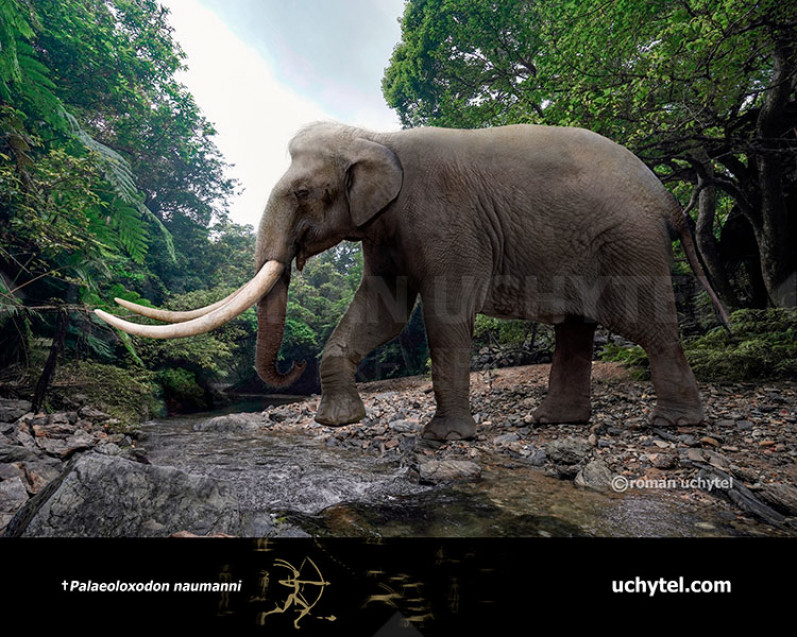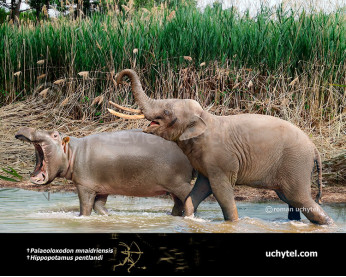Слон Науманна
20252802025280Слон Наумана (†Palaeoloxodon naumanni (Makiyama, 1924))
Синоніми: Elephas namadicus, Elephas namadicus naumannni, Palaeoloxodon namadicus naumannni
Ряд: Хоботні
Родина: Elephantidae
Розміри: довжина - 5 м (з бивнями), висота - 2,8 м, вага - 4 000 кг.
Розповсюдження: від середнього до пізнього плейстоцену (приблизно від 330 000 до 24 000 років тому, Японський архіпелаг)
Слон або Палєолоксодон Наумана— вимерлий вид з роду Palaeoloxodon, який жив на Японському архіпелазі в плейстоцені . Цей вид, як і інші слони, мав статевий диморфізм, самці P. naumanni мали реконструйовану висоту плечей 2,4–2,8 метра, самиці - близько 2 метрів. Це відносно мало порівняно з іншими звичайними видами палеолоксодонів того часу.
Palaeoloxodon naumanni відомий із сотень місць на Японському архіпелазі, починаючи від південного Кюсю і до північного Хонсю та Хоккайдо. Найновіші достовірні дати для цього виду – приблизно 24 000 років тому, під час ранніх етапів останнього льодовикового максимуму . Припускають, що він віддавав перевагу помірним лісовим середовищам, включаючи широколистяні дерева та хвойні породи, і вважається, що слон мешкав у широкому діапазоні висот, від рівня моря до понад 1000 метрів. Палєолоксодон Наумана жив поряд з іншими видами мегафауни, включаючи вимерлого гігантського оленя Sinomegaceros yabei, лося, вимерлого степового бізона, ведмедів, тигрів і вовків.
Деякі автори припускають, що його вимирання відбулося через кліматичні зміни, що призвели до втрати середовища та фрагментації популяції, тоді як інші припускають, що люди могли бути одним з факторів, що сприяли вимиранню.
Слон Наумана (†Palaeoloxodon naumanni (Makiyama, 1924))
Синоніми: Elephas namadicus, Elephas namadicus naumannni, Palaeoloxodon namadicus naumannni
Ряд: Хоботні
Родина: Elephantidae
Розміри: довжина - 5 м (з бивнями), висота - 2,8 м, вага - 4 000 кг.
Розповсюдження: від середнього до пізнього плейстоцену (приблизно від 330 000 до 24 000 років тому, Японський архіпелаг)
Слон або Палєолоксодон Наумана— вимерлий вид з роду Palaeoloxodon, який жив на Японському архіпелазі в плейстоцені . Цей вид, як і інші слони, мав статевий диморфізм, самці P. naumanni мали реконструйовану висоту плечей 2,4–2,8 метра, самиці - близько 2 метрів. Це відносно мало порівняно з іншими звичайними видами палеолоксодонів того часу.
Palaeoloxodon naumanni відомий із сотень місць на Японському архіпелазі, починаючи від південного Кюсю і до північного Хонсю та Хоккайдо. Найновіші достовірні дати для цього виду – приблизно 24 000 років тому, під час ранніх етапів останнього льодовикового максимуму . Припускають, що він віддавав перевагу помірним лісовим середовищам, включаючи широколистяні дерева та хвойні породи, і вважається, що слон мешкав у широкому діапазоні висот, від рівня моря до понад 1000 метрів. Палєолоксодон Наумана жив поряд з іншими видами мегафауни, включаючи вимерлого гігантського оленя Sinomegaceros yabei, лося, вимерлого степового бізона, ведмедів, тигрів і вовків.
Деякі автори припускають, що його вимирання відбулося через кліматичні зміни, що призвели до втрати середовища та фрагментації популяції, тоді як інші припускають, що люди могли бути одним з факторів, що сприяли вимиранню.


-797x638.jpg)

-70x56.jpg)
-346x277.jpg)
2018-346x277.jpg)


-cypriotes-346x277.jpg)
